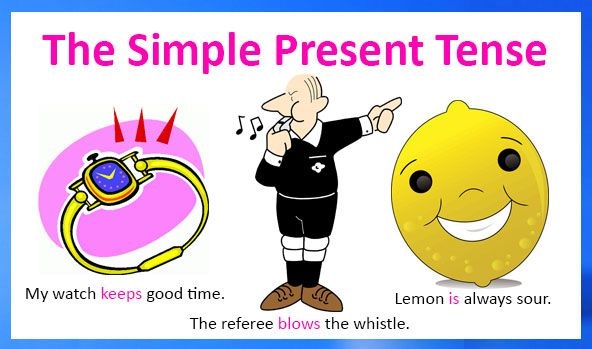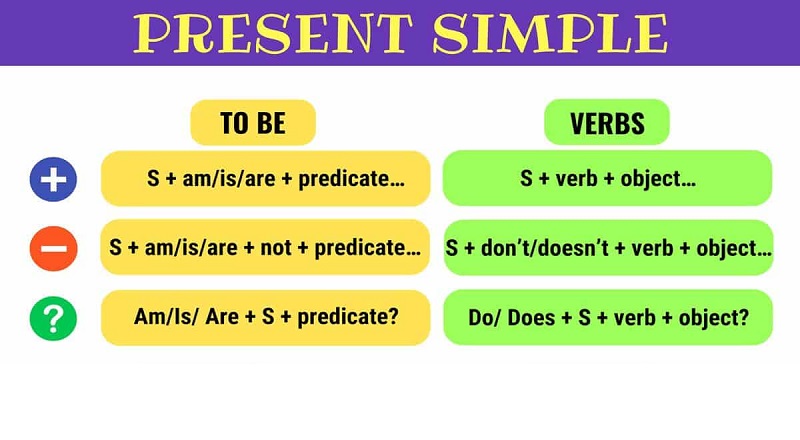Trong chương trình tiếng Anh cấp 2, các em học sinh lớp 7 sẽ tiếp tục được ôn tập và mở rộng phần kiến thức về thì hiện tại đơn – Present Simple. Với bài viết hôm nay, IELTS Cấp tốc mời các em cùng xem lại phần ngữ pháp tiếng Anh về thì này và làm một số bài tập Thì hiện tại đơn lớp 7 nhỏ để hệ thống lại kiến thức nhé!

Nội dung chính
Tổng quan về Thì hiện tại đơn
Cấu trúc với động từ To be
Câu khẳng định: S + am/ is/ are + N/ Adj
I + am = I’m
He/ She/ It/ Danh từ số ít/ Danh từ không đếm được + is = he’s / she’s / it’s
You/ We/ They/ Danh từ số nhiều/ Danh từ đếm được + are = You’re / we’re / they’re
Ví dụ: I am a police. (Tôi là cảnh sát.)
He is cold. (Anh ấy lạnh.)
They are doctors. (Họ là bác sĩ.)
Câu phủ định: S + am/ is/ are + not + N/ Adj
Ví dụ: I am not a police. = I’m not … (Tôi không phải là cảnh sát.)
He is not cold. = He isn’t … (Anh ấy không lạnh.)
They are not doctors. = They aren’t … (Họ không phải là bác sĩ.)
Câu nghi vấn:
Hỏi: Am/ Are/ Is (not) + S + N/Adj?
Đáp: – Yes, S + am/ are/ is.
– No, S + am not/ aren’t/ isn’t.
Ví dụ: Are you a doctor?
- Yes, I’m a doctor. / Yes, I am.
- No, I’m not a doctor. / No, I am not.
Ví dụ: Is he cold?
- Yes, he’s cold. / Yes, he is.
- No, he’s not cold. / No, he isn’t.
Cấu trúc với động từ thường
Câu khẳng định: S + V-infinitive
- I/ We/ You/ They/ Danh từ số nhiều + V1
Ví dụ: I understands English. (Tôi hiểu tiếng Anh.)
We like Math. (Chúng tôi thích môn tiếng Toán)
- He/ She/ It/ Danh từ số ít/ Danh từ không đếm được + V1 (s/es)
Ví dụ: She understands English. (Cô ấy hiểu tiếng Anh.)
He likes Math. (Anh ta thích môn Toán)
The Sun rises in the East. (Mặt trời mọc ở hướng Đông)
Câu phủ định: S + do/ does + not + V1 không chia s/es
“do”, “does” là các trợ động từ
do not = don’t
does not = doesn’t
- I don’t read the newspaper every day. (Tôi không đọc báo mỗi ngày)
- We don’t like watch news. (Chúng tôi không thích xem tin tức)
- He doesn’t go to work. (Anh ta không đi làm)
- She doesn’t play the piano. (Cô ta không chơi đàn piano)
Chú ý: Sau do/does và don’t/doesn’t thì ta không chia hay thêm s/es vào động từ
She doesn’t plays the piano. (Sai vì đã có “doesn’t” mà động từ “like” vẫn có đuôi “s”)
Câu đúng: She doesn’t play the piano.
Câu nghi vấn Yes/No:
Hỏi: Do/ Does (not) + S + V1 không chia s/es ?
Đáp: – Yes, S + do/ does.
– No, S + don’t/ doesn’t.
Ví dụ: Do you read books every week?
- Yes, I do. / Yes, I read books every week.
- No, I don’t. / No, I don’t read books every week.
Does she like to learn French?
- Yes, she does. / Yes, she likes to learn French.
- No, she doesn’t. / No, she doesn’t like to learn French.
Câu nghi vấn sử dụng từ hỏi bắt đầu bằng Wh-
WH- questions là các câu hỏi thường được bắt đầu với các từ để hỏi như Who (Ai), What (Cái gì), Which (Cái nào), Whose (Của ai), Where (Ở đâu), When (Khi nào), Why (Tại sao) và How (Thế nào).
| Động từ to be | Động từ thường | |
| Công thức | Wh- + am/ are/ is (not) + S + N/Adj? | Wh- + do/ does (not) + S + V1+…? |
| Ví dụ | – Where are you? (Bạn ở đâu?)- Who are they? (Họ là ai?) | – When does the train leave? (Khi nào tàu rời đi?) – Where do you buy bread? (Bạn mua bánh mì ở đâu?) |
Cách sử dụng và dấu hiệu nhận biết
Thì hiện tại đơn được sử dụng để:
• Nói về một thói quen lặp đi lặp lại hàng ngày: I always go to school at 8.am.
• Nói về sự thật, chân lý hiển nhiên: The sun rise in the east.
• Nói về khả năng của ai đó: She plays the piano very well.
• Trong cách sử dụng thì hiện tại đơn thường xuất hiện các trạng từ chỉ tần suất cơ bản như: always, usually, often, sometimes, rarely, every day, once a month, in the morning, once in a blue moon…
Để nhận biết thì hiện tại đơn, nên chú ý đến một số trạng từ chỉ tần suất:
- Always (luôn luôn)
- Usually (thường xuyên)
- Often/ Frequently/ Regularly (thường xuyên)
- Sometimes (thỉnh thoảng)
- Seldom/ Rarely/ Hardly (hiếm khi)
- Never (không bao giờ)
Một số cụm từ xuất hiện trong câu sử dụng thì hiện tại đơn:
Every + khoảng thời gian (every month,…)
Once/ twice/ three times/ four times + khoảng thời gian (once a week,..)
In + buổi trong ngày (in the morning,…)
Bài tập Thì hiện tại đơn lớp 7

Bài 1: Add –s , -ies or -es to the verbs
E.g.: see → sees
- wake
- take
- teach
- brush
- catch
- kiss
- pass
- call
- come
- give
Bài 2: Fill in the blank with “don’t” or “doesn’t”
- Bill _____ play tennis every Sunday.
- My cousin _____ know Italian well.
- We _____ go to the park.
- I _____ like to walk to school.
- Kate _____ like to eat fish.
- Pam _____ go to the gym.
- Sue _____ wear long dresses.
- They _____ understand this rule.
- I _____ like to get up early.
- We _____ often go to the movies.
Bài 3: Complete the sentences with the Present Simple form of the given verbs
- They ___________ football at school. (to play)
- She ___________ emails. (not/to write)
- ___________ you ___________ English? (to speak)
- My parents ___________ fish. (not/to like)
- ___________ Anne ___________ any hobbies? (to have)
- Andy’s brother ___________ in an office. (to work)
- Leroy ___________ very fast. (can/not/to read)
- ___________ Jim and Joe ___________ the flowers every week? (to water)
- Yvonne’s mother ___________ a motorbike. (not/to ride)
- ___________ Elisabeth ___________ cola? (to drink)
Bài 4: Fill in the blank with the Present Simple form of the following verbs
| wake(s) up – open(s) – speak(s) – take(s) – do(es) – cause(s) – live(s) – play(s) – close(s) – live(s) – drink(s) |
- Ann ___________ handball very well.
- I never ___________ coffee.
- The swimming pool ___________ at 7:00 in the morning.
- It ___________ at 9:00 in the evening.
- Bad driving ___________ many accidents.
- My parents ___________ in a very small flat.
- The Olympic Games ___________ place every four years.
- They are good students. They always ___________ their homework.
- My students ___________ a little English.
- I always ___________ early in the morning.
Bài 5: Read and answer the questions
David wants to buy a Christmas present for a very special person, his mother. David’s father gives him $5.00 a week pocket money and David puts $2.00 a week into his bank account. After three months David takes $20.00 out of his bank account and goes to the shopping mall. He looks and looks for a perfect gift.
Suddenly he sees a beautiful brooch in the shape of his favourite pet. He says to himself, “My mother loves jewelry, and the brooch costs only $17.00.” He buys the brooch and takes it home. He wraps the present in Christmas paper and places it under the tree. He is very excited and he is looking forward to Christmas morning to see the joy on his mother’s face.
But when his mother opens the present she screams with fright because she sees a spider.
- What does David want to buy his Mother?
- a special birthday present
- a Christmas present
- a spider ring
- Who does David get his money from?
- his pet
- his mother
- his father
- How much money does David take to the mall?
- $20.00
- $5.00
- $17.00
- What does David buy his mother?
- a ring
- a brooch
- a spider
- What does David do with the present when he takes it home?
- he gives it to his mother
- he wraps it in Christmas paper
- he is very excited
- Why does David’s mother scream?
- because the present is beautiful
- because she doesn’t like Christmas presents
- because she thinks she sees a real spider
- Why does David buy a spider brooch?
- spiders are his favourite pet
- he loves Christmas
- to scare his mother
- Where does David put the present on Christmas Eve?
- under his pillow
- under a spider
- under the Christmas tree
Đáp án
Bài 1
- wakes
- takes
- teaches
- brushes
- catches
- kisses
- passes
- calls
- comes
- gives
Bài 2
- Doesn’t
- Doesn’t
- Don’t
- Don’t
- Doesn’t
- Doesn’t
- Doesn’t
- Don’t
- Don’t
- Don’t
Bài 3
- Play
- Doesn’t write
- Do – speak
- Don’t like
- Does – have
- Works
- Can’t read
- Do – water
- Doesn’t ride
- Does – drink
Bài 4
- Ann plays handball very well.
- I never drink coffee.
- The swimming pool opens at 7:00 in the morning.
- It closes at 9:00 in the evening.
- Bad driving causes many accidents.
- My parents live in a very small flat.
- The Olympic Games take place every four years.
- They are good students. They always do their homework.
- My students speak a little English.
- I always wake up early in the morning.
Bài 5
- a Christmas present
- his father
- $20.00
- a brooch
- he wraps it in Christmas paper
- because she thinks she sees a real spider
- spiders are his favourite pet
- under the Christmas tree
Hy vọng với phần ôn lại kiến thức cũng như hoàn thành các bài tập Thì hiện tại đơn lớp 7 (Present Simple tense), IELTS Cấp tốc đã giúp các em học sinh lớp 7 nắm vững hơn về cách sử dụng thì này trong tiếng Anh. Chúc các em học tốt!

